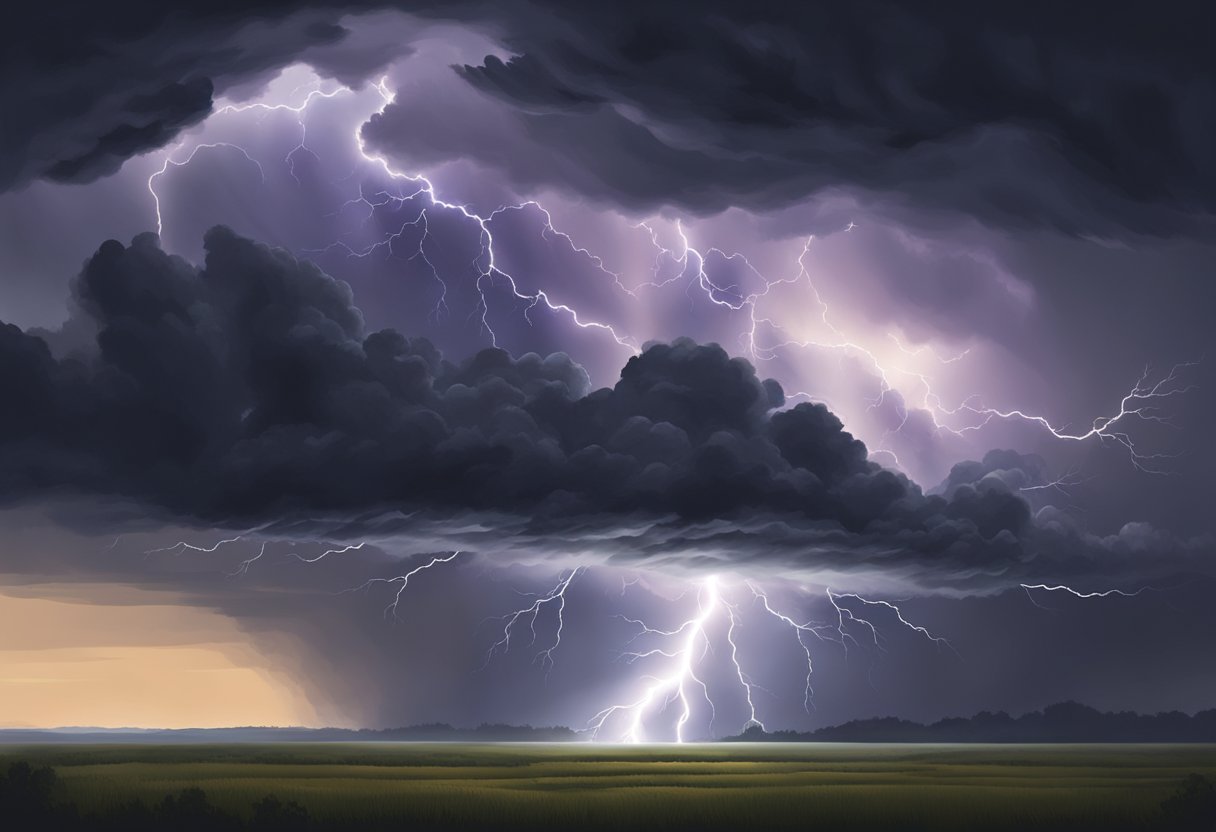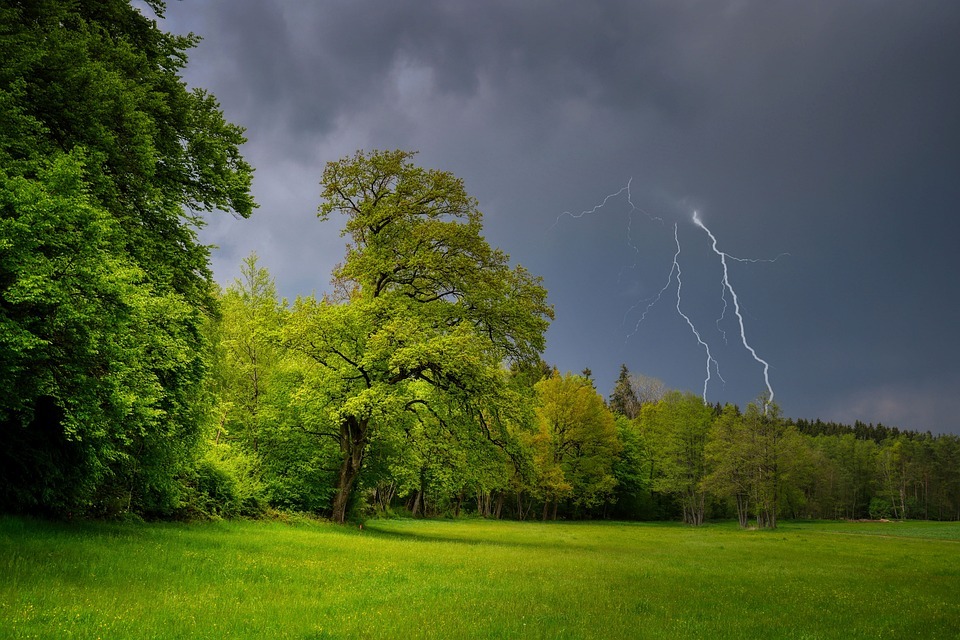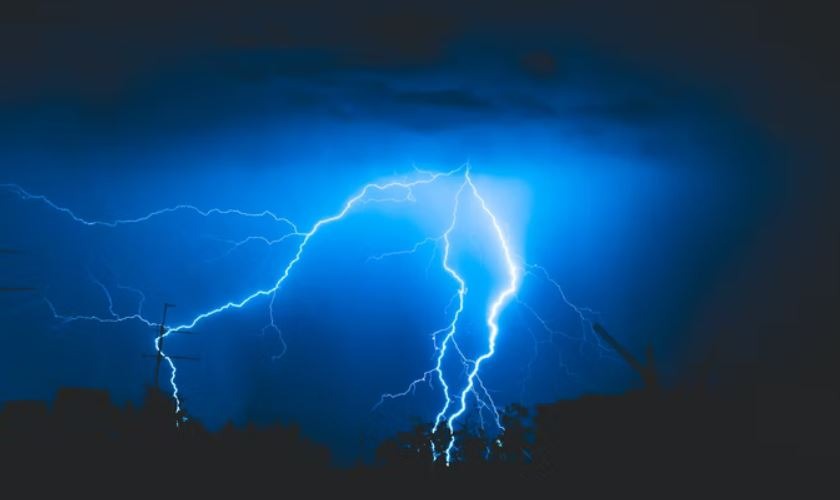The Relationship Between Lightning and Thunder: Timing and Sound
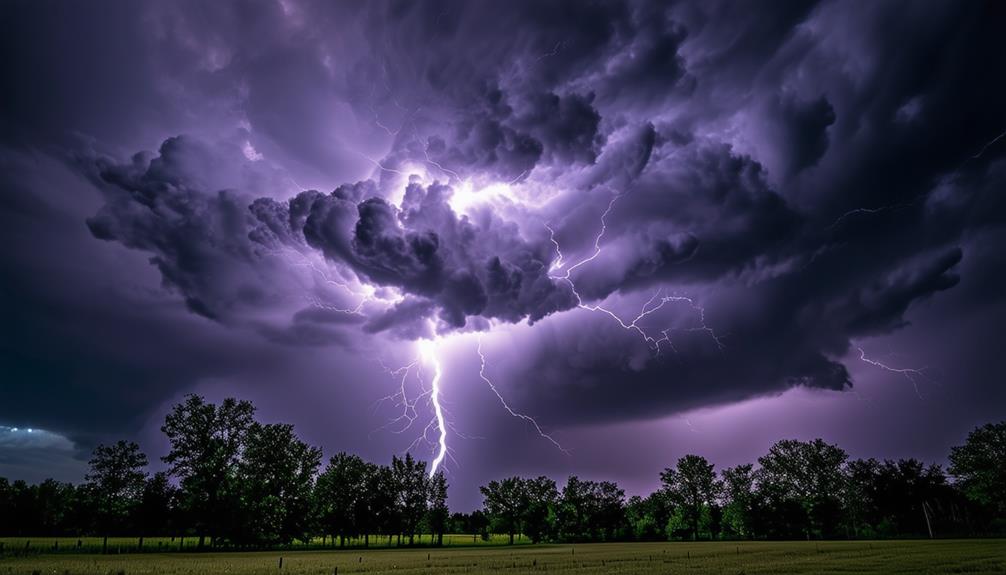
When you see a flash of lightning, your instinct might be to count the seconds until you hear the thunder. This practice has a scientific basis that helps you estimate the storm's distance. Lightning's intense heat causes rapid air expansion, creating shockwaves that we hear as thunder. By understanding the timing and sound of these phenomena, you can gauge the distance of a lightning strike with surprising accuracy. But how exactly does this process work, and what implications does it have for your safety?
Understanding Thunder
Thunder is the sound produced when lightning rapidly heats and cools the surrounding air. When lightning strikes, it can heat the air up to 50,000 degrees Fahrenheit, causing the air to expand explosively. This sudden expansion generates a shockwave that travels through the air, creating the sound known as thunder.
The process begins with the lightning bolt. As it travels through the atmosphere, it heats the surrounding air almost instantaneously. This rapid heating causes the air molecules to vibrate and expand quickly, generating a shockwave similar to a small explosion. Subsequently, the air cools and contracts rapidly, further contributing to the thunderous sound.
Thunder serves as a crucial warning signal. Hearing it indicates that lightning is nearby, and you should seek shelter immediately.
The time interval between seeing a lightning flash and hearing the thunder can help estimate the distance of the lightning strike. Generally, every five seconds between the flash and the sound corresponds to approximately one mile. This knowledge helps you assess the immediate danger and take appropriate safety measures.
How Thunder Is Created
When lightning strikes, it rapidly heats the surrounding air to temperatures exceeding 50,000 degrees Fahrenheit, causing the air to expand explosively. This sudden expansion of air molecules generates a shock wave that travels through the atmosphere, producing the sound we recognize as thunder.
As the heated air quickly cools, it contracts just as rapidly, further contributing to the formation of the shock wave. This transition from expansion to contraction happens almost instantaneously, which is why thunder often follows a lightning flash so closely.
Calculating Thunder Distance
To estimate the distance of a lightning strike, count the seconds between the flash and the thunder, then divide by 5. Sound travels at approximately 1,200 feet per second in air, enabling this calculation. For example, if there's a 5-second gap between the lightning and thunder, the lightning strike is roughly 1 mile away.
Understanding the timing difference between lightning and thunder is crucial for this estimation. Light travels almost instantaneously, while sound takes longer to reach you, creating the observable time gap. The longer this gap, the farther away the storm. The nature of the thunder sound also provides clues. A sharp crack usually indicates a closer strike, whereas a distant rumble suggests a farther one.
Lightning and Thunder Timing
Estimating the distance of a lightning strike involves timing the interval between the flash and the thunder. When you see a lightning flash, count the seconds until you hear the thunder. Light travels faster than sound, so by dividing the number of seconds by five, you can estimate the distance in miles. For example, if you count 10 seconds, the lightning strike is roughly 2 miles away.
Understanding this timing is crucial for safety, as lightning can strike miles away from the storm's center, and thunder can be heard within a 10-mile radius. Knowing how to gauge this distance can help you decide if you need to seek shelter.
Sound travels at approximately 1,100 feet per second, allowing you to make these calculations quickly. Remember, the shorter the time interval between the lightning flash and the thunder, the closer the storm. This method provides valuable information about your immediate environment during a thunderstorm.
Safety Precautions
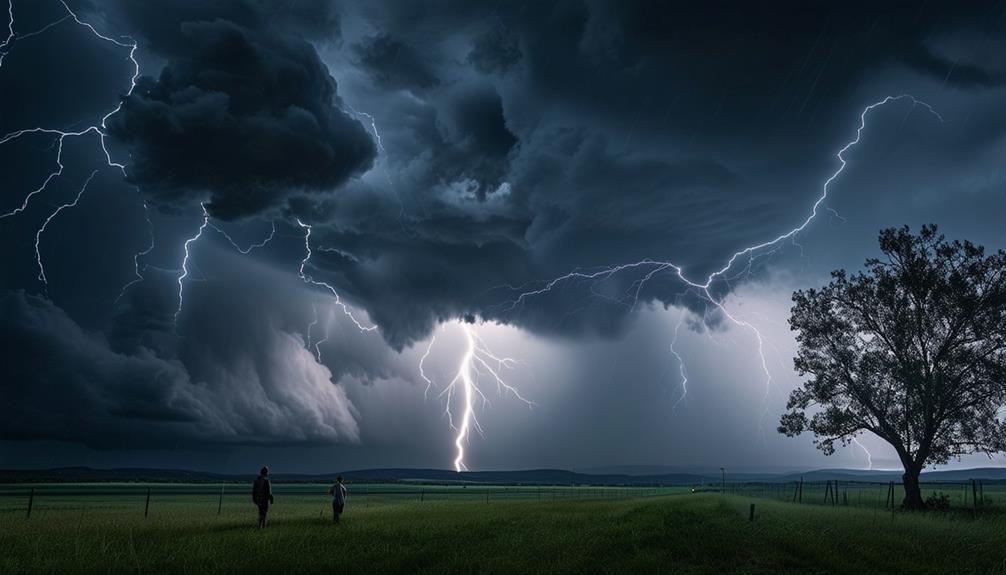
When you hear thunder, seek immediate shelter, as it indicates nearby lightning. Don't wait for the storm to approach; act promptly. To ensure your safety, avoid outdoor activities and find a secure indoor location.
Seek Immediate Shelter
Hearing thunder means you should seek immediate shelter to stay safe from lightning strikes. Thunder serves as a critical warning sign that you're within striking distance of a lightning storm. Since sound travels slower than light, you hear thunder after seeing lightning, providing a window of opportunity to find safety.
Follow these guidelines to ensure your safety:
- Seek sturdy shelter: The safest place is inside a well-constructed building. Avoid small structures like sheds or pavilions.
- Stay away from windows: Once indoors, avoid windows, doors, and anything that conducts electricity, like wired electronics.
- Use the 30/30 rule: If you hear thunder within 30 seconds of seeing lightning, you're within striking distance. Remain indoors for at least 30 minutes after the last thunderclap.
- Avoid tall objects: If you can't get indoors, steer clear of tall structures like trees and poles, as they're more likely to be struck by lightning.
Following these steps can significantly reduce your risk of lightning-related accidents and injuries.
Avoid Outdoor Activities
Upon hearing thunder, immediately cease any outdoor activities to minimize the risk of being struck by lightning. Thunder indicates the proximity of lightning, signaling that the storm is close enough to pose a real danger. Your primary objective should be to seek shelter as quickly as possible. Safe locations include buildings with electrical wiring and plumbing, which can help ground lightning strikes, or hard-topped vehicles.
It might be tempting to wait out the storm outdoors, but adhering to safety guidelines is crucial. Once indoors, stay away from windows and avoid using electrical appliances. Just because the thunder seems to have subsided doesn't mean the danger has passed.
Wait at least 30 minutes after the last sound of thunder before resuming any outdoor activities. This measure ensures the storm has moved a safe distance away, reducing the likelihood of a lightning-related incident.
The Lightning 30/30 Rule
If you hear thunder within 30 seconds of seeing lightning, the storm is dangerously close. To reduce the risk of lightning-related accidents, follow the 30/30 rule: wait 30 minutes after the last thunder before going outdoors. This guideline serves as an important safety measure, helping you stay protected during thunderstorms.
Proximity Indicator
The Lightning 30/30 Rule helps you gauge the proximity of a storm by measuring the time between seeing lightning and hearing thunder. When you see a lightning flash, start counting the seconds until you hear the thunder. If the time is 30 seconds or less, the storm is within six miles of your location. This rule is crucial for safety, as it indicates the storm is close enough to pose a danger.
Here are some essential points to remember:
- Count the seconds: Begin counting immediately after you see the lightning flash.
- Distance calculation: Hearing thunder within 30 seconds means the storm is within six miles.
- Seek shelter: If the interval is 30 seconds or less, find shelter immediately.
- Safety protocol: This straightforward calculation helps you assess the storm's proximity and take necessary precautions.
Understanding and applying this rule can be lifesaving during thunderstorms.
Safety Timeframe
Adhering to the Lightning 30/30 Rule is crucial for determining when it's safe to resume outdoor activities during a thunderstorm. This rule helps you measure the interval between a lightning flash and the sound of thunder. If you see a flash and hear thunder within 30 seconds, the storm is dangerously close, and you should immediately take shelter. Each second between the flash and thunder indicates roughly one mile of distance from the lightning.
To ensure your safety, wait at least 30 minutes after the last flash of lightning before heading back outside. This 30-minute wait period is critical because it allows the storm to move away, reducing the risk of a sudden lightning strike.
Risk Mitigation
Understanding how to mitigate risks during a thunderstorm involves effectively applying the Lightning 30/30 Rule to ensure personal safety. The National Weather Service recommends this rule: if you hear thunder within 30 seconds of seeing lightning, the storm is close enough to pose a danger. You should immediately seek shelter and remain there until at least 30 minutes after the last sound of thunder.
Following the Lightning 30/30 rule can significantly reduce the risk of lightning-related accidents. Here's how you can apply it for better thunderstorm safety:
- Count the seconds: When you see lightning, start counting. If you hear thunder before you reach 30, seek shelter immediately.
- Stay informed: Monitor weather reports, especially from reliable sources like the National Weather Service, to know if thunderstorms are expected.
- Wait it out: Don't resume outdoor activities until 30 minutes have passed since the last thunderclap.
- Shelter smartly: Find a substantial building or a hard-topped vehicle to wait out the storm.
Protecting Property From Lightning
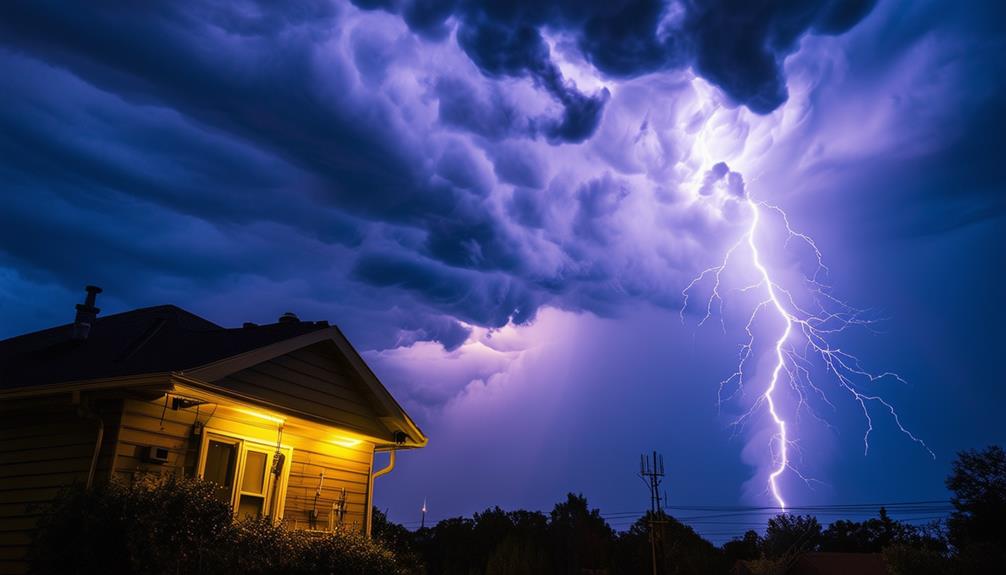
Implementing effective lightning protection systems is essential for safeguarding both residential and commercial properties from direct and indirect lightning strikes. To minimize lightning damage, focus on three key elements: structural protection, bonding and grounding, and surge protection. These proactive measures can prevent significant harm and enhance the safety of your property.
A comprehensive lightning protection system includes several components that work in unison to shield your property. Structural protection involves installing lightning rods and conductive paths to ensure the lightning's energy is safely directed to the ground, thereby preventing structural damage. Bonding and grounding are critical for creating a continuous path to the earth, which helps prevent electrical surges and reduces the risk of fires. Surge protection devices are essential for shielding electrical appliances and systems from voltage spikes caused by lightning strikes.
| Component | Function | Benefit |
|---|---|---|
| Structural Protection | Directs lightning safely to the ground | Prevents structural damage |
| Bonding and Grounding | Ensures a continuous path to the earth | Reduces the risk of fires and electrical surges |
| Surge Protection | Shields appliances from voltage spikes | Protects electronic devices and systems |
Speed of Sound Calculation
When you hear thunder after seeing a lightning flash, you can estimate the distance to the lightning strike by calculating the speed of sound. The speed of sound in dry air is approximately 1,087 feet per second. By timing the interval between the lightning flash and the subsequent thunder, you can determine the lightning strike's distance.
Here's how you can do it:
- Observe the lightning flash: As soon as you see a lightning flash, start counting the seconds until you hear the thunder.
- Measure the time interval: The number of seconds you count is the time interval between the lightning flash and the thunder.
- Calculate the distance: Multiply the number of seconds by the speed of sound. For example, if you count 5 seconds, multiply 5 by 1,087 feet per second to get 5,435 feet.
- Convert to miles: For a quick estimate, divide the distance in feet by 5,280 (the number of feet in a mile). In our example, 5,435 feet divided by 5,280 equals about 1.03 miles.
Knowing the speed of sound allows you to accurately calculate the distance of a lightning strike.
It's fascinating how timing the sound wave's travel can provide such precise information. So next time there's a storm, you'll know exactly how far away that lightning is!
Thunderstorm Safety Measures
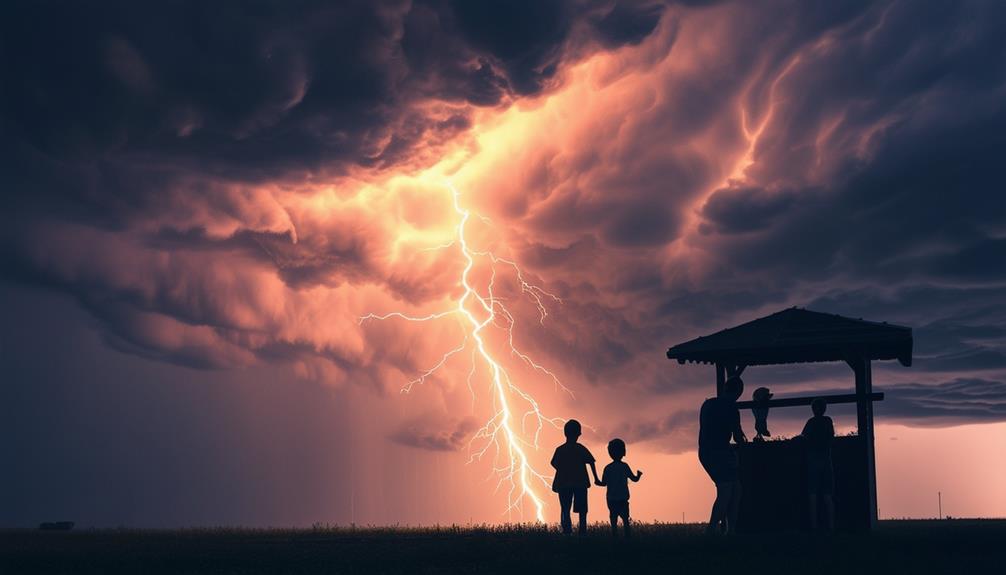
When you hear thunder, seek shelter immediately to protect yourself from lightning strikes. The sound of thunder indicates that lightning has struck nearby. To estimate the proximity of the lightning, use the flash-to-bang method: count the seconds between the flash of lightning and the sound of thunder. Every five seconds equates to one mile of distance.
Following the 30/30 rule is crucial for thunderstorm safety. If you count 30 seconds or less between seeing lightning and hearing thunder, the storm is dangerously close. Stay indoors and wait at least 30 minutes after the last thunderclap before going back outside. This rule reduces the risk of lightning strikes, which can occur even if the storm seems to be moving away.
Conclusion
Understanding the relationship between lightning and thunder can help you gauge the distance of a lightning strike and stay safe during thunderstorms. For every 5 seconds between a lightning flash and the resulting thunderclap, the storm is approximately 1 mile away. This method allows you to estimate how close the storm is and take appropriate precautions.
Follow the 30/30 rule for safety: seek shelter if the time between a lightning flash and thunder is 30 seconds or less, and remain indoors for at least 30 minutes after the last thunderclap. This rule helps protect you from the dangers of lightning strikes during and after a storm. Stay vigilant and prioritize your safety during thunderstorms.


